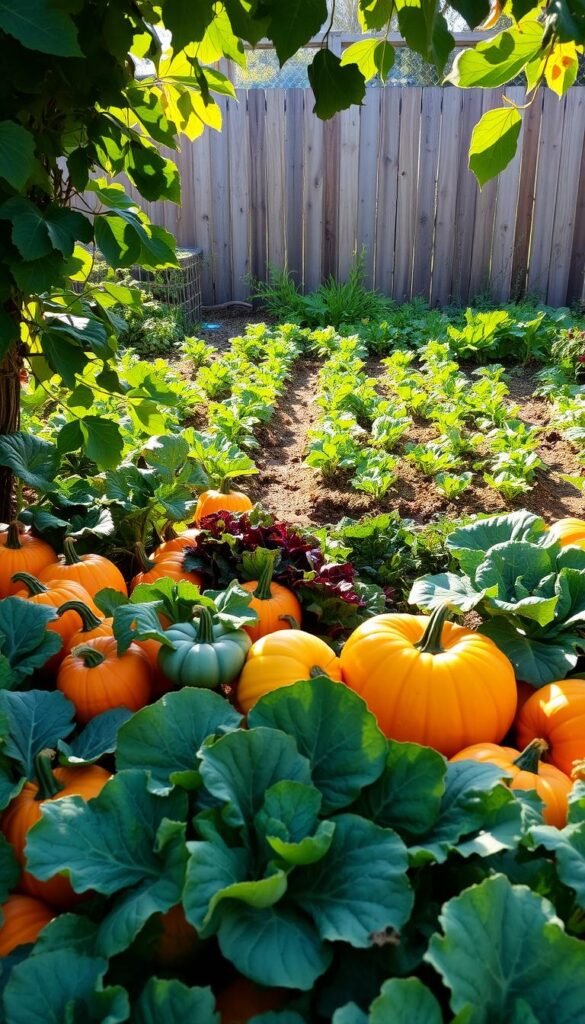Did you know your backyard can keep producing fresh greens and crisp roots long after summer ends? With thoughtful planning, you can enjoy homegrown meals even as temperatures drop. This approach lets you squeeze every bit of value from your outdoor space while embracing nature’s rhythms.
Many crops actually prefer brisk autumn days to scorching summer heat. Leafy greens like kale and spinach develop sweeter flavors after light frosts, while root vegetables store energy for winter in their crunchy cores. Even better? These plants often require less watering and pest control than warm-weather varieties.
Starting a late-season plot gives beginners a perfect entry point. Fast-growing options like radishes and lettuce deliver quick wins, building confidence for future projects. You’ll also stretch your local growing season—some hardy varieties thrive in zones as chilly as 6, tolerating frosty nights down to 20°F.
Imagine stepping outside to gather ingredients while your neighbors buy limp supermarket produce. Cooler weather gardening means fewer weeds, fewer bugs, and more time to savor the crisp air. Best of all, you’ll gain weeks—or even months—of fresh meals from the same patch of soil.
Understanding Fall Gardening in Cooler Months
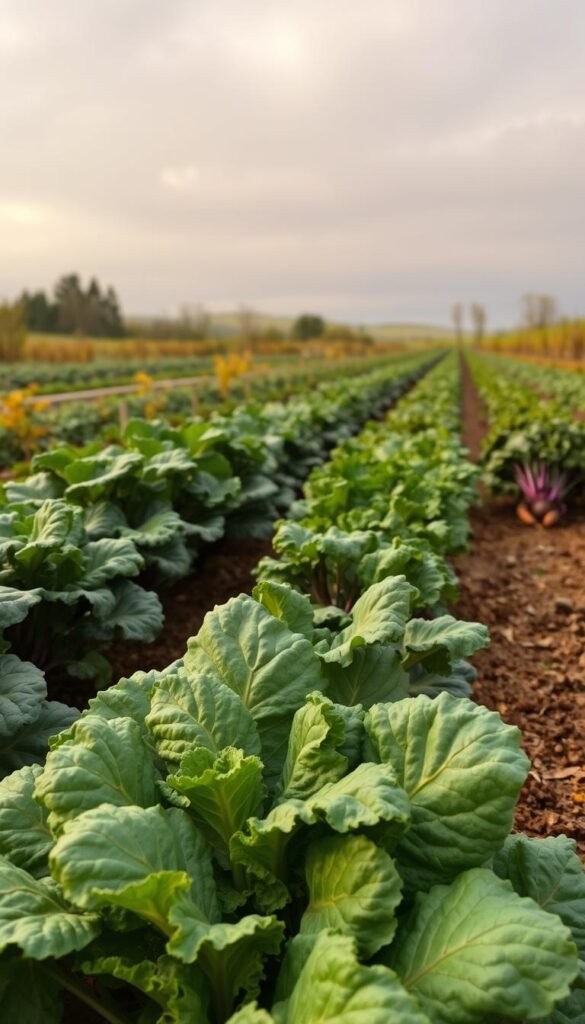
Ever wondered why some veggies taste better when the air turns crisp? Nature’s temperature shifts trigger remarkable changes in cold-tolerant crops. Let’s explore how dropping mercury levels and shorter days create ideal conditions for specific varieties.
Seasonal Shifts Create Sweet Spots
As daylight dwindles, cool-weather plants activate survival modes. They pump sugars into their cells—a natural antifreeze that protects tissues. This sugar boost makes greens like spinach taste milder and root veggies like carrots crunchier.
Check out how temperature ranges affect popular crops:
| Crop Type | Optimal Temp Range | Frost Tolerance | Flavor Change |
|---|---|---|---|
| Tomatoes (warm-season) | 70-85°F | Damaged below 50°F | Becomes mealy |
| Kale (cool-season) | 45-75°F | Survives 20°F | Sweeter after frost |
Why Chill Makes Crops Thrive
Cooler weather slows plant metabolism, letting nutrients concentrate. Broccoli develops tighter florets, while radishes gain that signature peppery zing. These changes happen gradually—a sudden freeze shocks plants, but a steady cool-down strengthens them.
Timing matters most. Start seeds when soil stays between 60-70°F for quick germination. Watch your local frost dates like a hawk—they’ll determine your harvest window. With smart planning, you’ll turn temperature drops into flavor boosts!
Benefits and Challenges of a Fall Vegetable Garden
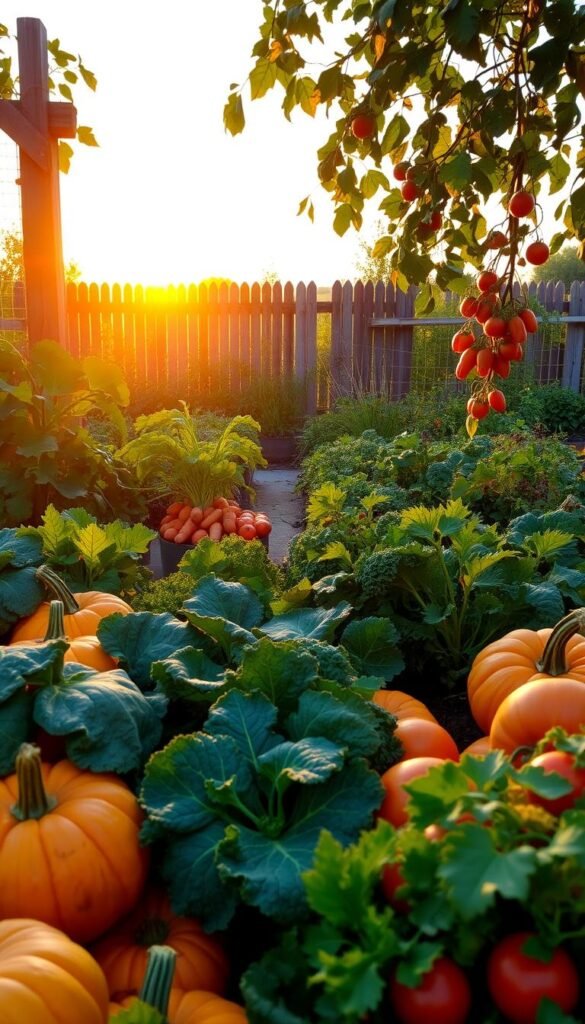
Autumn’s crisp air does more than signal sweater weather—it transforms your crops. While late-season planting offers unique advantages, it also demands smart strategies to handle nature’s curveballs. Let’s unpack why this growing period can be both rewarding and tricky.
Enhanced Flavors and Lower Pest Pressure
Cooler temperatures work magic on leafy greens and root crops. Plants like arugula and beets produce natural sugars as frost approaches, giving them a sweeter kick than their summer counterparts. You’ll also notice fewer aphids and caterpillars—many pests can’t survive chilly nights.
Evaporation slows dramatically in autumn, meaning your soil holds moisture longer. This cuts watering frequency by up to 40% compared to July’s heat. Your plants stay hydrated without constant attention, freeing up time for other tasks.
Navigating Frost Risks and Shorter Daylight Hours
Early frosts can ambush unprepared gardeners. While light freezes improve flavor, hard frost below 28°F damages cell structures. Use this table to balance risks and rewards:
| Factor | Advantage | Challenge |
|---|---|---|
| Temperature | Sweeter produce | Bolting during warm spells |
| Daylight | Less watering | Slower growth rates |
| Pests | Natural insect control | Rodent activity increases |
Watch for surprise heat waves that trick plants into flowering prematurely. Time your harvest carefully—you’ve got about 2-3 weeks after the first frost to gather most crops. Success lies in adapting to autumn’s unpredictable rhythm!
Planning Your Planting Schedule
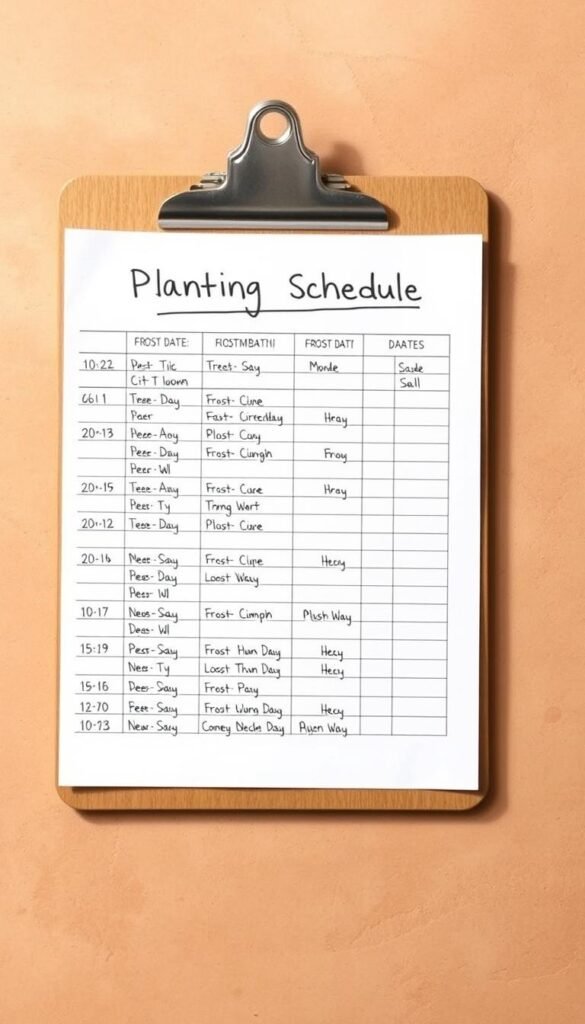
Timing is everything when it comes to squeezing the last drops of productivity from your soil before winter’s chill sets in. Nail your schedule, and you’ll enjoy fresh greens and roots long after summer fades. Miss the window, and frost might claim your crops before they’re ready.
Determining Your First Frost Date
Your local agricultural extension office holds the golden ticket—your area’s average first frost date. This number shapes every decision, from seed selection to harvest timing. Plug your zip code into online tools like the USDA Plant Hardiness Zone Map for precision.
Calculating Growing Times for Quick-Harvest Crops
Work backward from your frost date using this formula:
- Days to maturity + 14 days buffer = Total growing time
Check this table for popular options:
| Crop | Maturity Days | Buffer Days |
|---|---|---|
| Radishes | 21 | 14 |
| Mustard Greens | 28 | 14 |
| Baby Lettuce | 35 | 14 |
Stagger plantings every 14-21 days for nonstop harvests. Mature crops handle cold better than seedlings, so err on the early side. Those extra two weeks? They’re your insurance policy against sluggish autumn growth.
Selecting Cold-Hardy Vegetables and Crops for Autumn
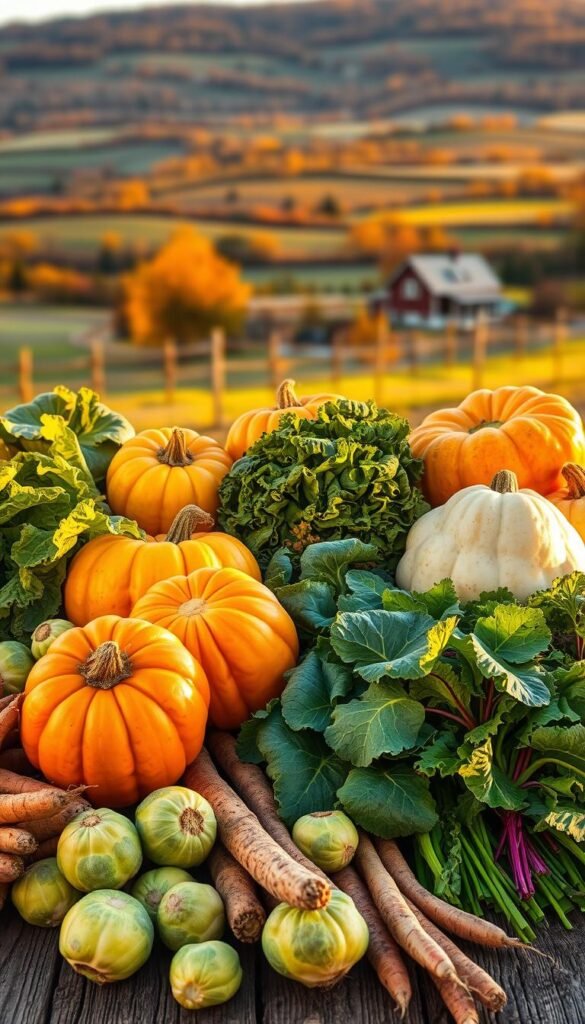
What if your autumn garden could outlast the first frost with crisp greens and sweet roots? The secret lies in choosing plants that laugh at chilly nights. Let’s explore three powerhouse groups that turn frost into flavor.
Leafy Greens That Defy the Cold
Butterhead lettuce forms tender cups perfect for wraps, while romaine adds crunch to salads. Spinach like ‘Bloomsdale’ delivers baby leaves in 28 days. Swiss chard ‘Celebration’ brings rainbow stems to brighten gray days. These greens thrive when temperatures dip below 60°F.
Root Vegetables That Sweeten With Age
Carrot ‘Carnival Blend’ reveals purple and yellow hues under cold soil. French Breakfast radishes mature in 21 days—ideal for quick harvests. For winter storage, try Round Black Spanish radishes. Beets like ‘Gourmet Blend’ develop candy-like sweetness after light frosts. Their root systems store energy like nature’s pantry.
Brassicas Built for Brisk Weather
Kale ‘Red Russian’ produces frilly leaves packed with frost-induced sugars. Compact Brussels sprouts ‘Long Island Improved’ withstand snow flurries. Cauliflower ‘Snowball Y’ wraps its florets in protective leaves. These crops actually improve in flavor as mercury drops.
Mix lettuce varieties with quick-growing roots and sturdy brassicas for nonstop harvests. Pairing early radishes with late kale creates a staggered yield. For more ideas on growing in chilly temperatures, explore our cold-weather planting guide. Your autumn plot will serve up textures and tastes summer gardens can’t match!
Garden Preparation and Soil Management
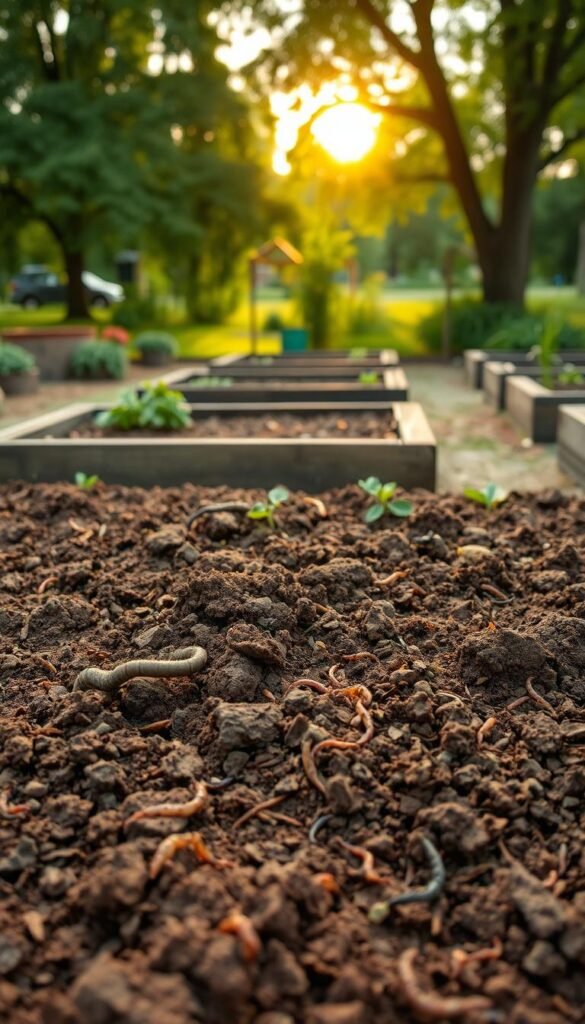
Your soil works overtime during summer, leaving it hungry for renewal. Think of autumn planting as hitting the reset button—a chance to rebuild your garden’s foundation for robust growth. Smart soil care now means tastier produce later.
Rebuilding Earth’s Buffet
After summer crops drain nutrients, your soil needs a balanced meal. Spread 1-2 inches of compost over beds, then gently mix it into the top layer. This “top dressing” feeds microorganisms while improving texture.
Compare popular amendments:
| Material | Nitrogen Boost | Drainage Improvement |
|---|---|---|
| Aged Compost | Medium | High |
| Worm Castings | High | Medium |
| Leaf Mold | Low | Exceptional |
Looser earth lets roots breathe. Test your soil by squeezing a handful—it should crumble easily. If it forms a tight ball, add more organic matter. This simple trick prevents stunted carrots and twisted beets.
Mulch acts like a cozy blanket. Straw or shredded leaves keep moisture steady while blocking weeds. Your plants get consistent hydration without daily watering. Healthy soil means fewer pests and better flavor in every bite!
Using Season Extension Techniques
Ever thought your plot could defy frost’s bite? Simple tools and smart scheduling let you push nature’s limits. These methods create cozy pockets where plants thrive despite dropping mercury levels.
Cold Frames vs. Row Covers: Your Frost Fighters
Cold frames work like solar ovens for your greens. These bottomless boxes trap warmth using sunlight and angled glass lids. Position them south-facing to catch maximum light during shorter days.
Row covers act as breathable blankets. Drape these lightweight fabrics directly over planting beds—they let rain through while blocking icy winds. Choose thicker grades (0.5 oz+) for hardier protection.
| Method | Materials | Temp Boost | Best For |
|---|---|---|---|
| Cold Frames | Wood/plastic + glass | 10-20°F | Seedlings & mature plants |
| Row Covers | Polyester fabric | 4-8°F | Quick crops & frost shields |
Keep Harvests Coming With Smart Timing
Succession planting turns one harvest into three. Sow fast-growers like arugula every 14 days—as you pick one batch, the next matures. Try this staggered schedule:
- Week 1: Plant spinach & radishes
- Week 3: Add mustard greens
- Week 5: Start more lettuce
Pair these tactics to extend growing season yields. Cold frames protect late starters, while row covers shield early sprouts. You’ll enjoy crunchy salads while others shovel snow!
Fall Vegetable Garden: Extending Your Harvest into Cooler Months
Unlocking your plot’s full potential requires more than just planting seeds—it’s about strategic choices that turn chilly days into bounty. Let’s explore how smart techniques can transform limited space into a nonstop production line, even as thermostats plummet.
Smart Strategies for Abundant Yields
Cold-hardy varieties like ‘Winter Density’ lettuce or ‘Arctic King’ spinach thrive when others wilt. These champions develop richer flavors under stress, turning frost into a flavor enhancer. Pair them with quick-growing radishes for staggered harvests that keep your kitchen stocked.
Space becomes gold in cooler months. Try these space-saving methods:
| Method | Space Used | Yield Increase | Best For |
|---|---|---|---|
| Interplanting | Shared beds | 40-60% | Lettuce + radishes |
| Vertical Growing | Wall space | 200% | Peas & dwarf beans |
| Succession | Same soil | 3+ crops | Spinach & arugula |
Floating row covers boost temperatures by 4-8°F—enough to prevent frost damage without overheating plants. Remove them during sunny afternoons to avoid condensation buildup. For those starting their cool-season journey, focus on varieties with under 50 days to maturity.
Monitor soil moisture weekly—cooler air tricks us into under-watering. Stick your finger two inches deep; if it’s dry, give plants a morning drink. “The best autumn harvests come from gardens that adapt daily,” says veteran grower Marissa Towne. Stay vigilant, and your plot will reward you through winter’s first whispers.
Caring for Your Garden Throughout the Cooler Months
Those crisp mornings don’t mean your gardening gloves get retired—they signal a shift in plant care priorities. Balancing hydration and insulation becomes your secret weapon against unpredictable weather patterns. Let’s explore how smart adjustments keep your greens thriving as days shorten.
Water Wisdom for Changing Conditions
Your watering can gets a lighter workout now. Check soil moisture by poking your finger an inch deep—if it feels dry, give plants a slow, deep drink. This encourages roots to dig deeper for stability. Overwatering risks rot in cooler temperatures, so let the top layer dry slightly between sessions.
Compare these organic mulches for best results:
| Material | Moisture Retention | Insulation Value |
|---|---|---|
| Shredded Leaves | High | Moderate |
| Straw | Medium | High |
| Grass Clippings | Medium | Low |
Mulch Magic and Vigilant Monitoring
A 3-inch mulch layer acts like a thermostat for plant roots. It prevents sudden soil temperature swings while locking in precious moisture. Watch for curled leaves or slowed growth—these signal stress from dry spells or cold snaps. Cover tender plants with cloths during frost warnings, removing them when sun returns.
Remember: Dormant doesn’t mean dead. Many crops like kale and carrots continue developing under snowpack. Keep beds clear of debris to discourage rodents seeking winter snacks. With these tweaks, you’ll enjoy fresh-picked meals straight through the winter holidays!
Wrapping Up Your Autumn Garden Journey
As the final leaves drop, your plot’s potential is just waking up. Cool-season gardening rewards patience with crisp salads and earthy roots long after summer fades. With smart crop choices and simple protections, you’ll savor homegrown meals while others bundle up for grocery runs.
Focus on plants that thrive in brisk air, like frost-sweetened kale or cold-hardy carrots. These champions adapt to shorter days, turning challenges into flavor boosts. Pair them with quick growers like radishes for staggered yields that keep your kitchen stocked.
Remember: Timing and soil care make all the difference. Start seeds early enough to beat deep freezes, and enrich beds with compost for robust growth. For a detailed guide on cold-hardy crops, explore our expert tips to maximize your success.
Your efforts now pay dividends beyond fresh produce—you’re building skills for year-round growing. Each crunchy bite proves nature’s resilience, and your ability to work with its rhythms. Keep experimenting, and watch your plot defy expectations!

